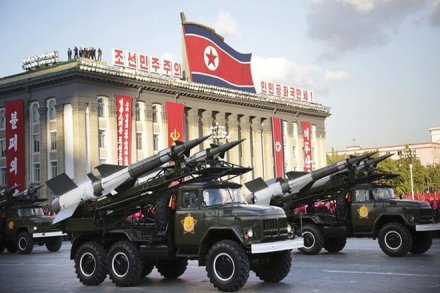The North Korean weapons programme now testing US President Donald Trump stretches back decades, when the regime began reverse-engineering Scud missiles acquired from Egypt. International efforts to curb North Korea’s nuclear threat were dealt a setback in 2006 with the country’s first successful bomb test, and former leader Kim Jong Il abandoned talks a few years later. His son and successor, Kim Jong Un, has only accelerated the program, testing more sophisticated technology in defiance of international sanctions.
Here’s a detailed history of North Korea’s weapons programs:
1976-81: North Korea begins missile development using Scud-B from the Soviet Union and launchpad from Egypt
1984: First Scud-B missile test firing
1988: Operational deployment of Scud-B and Scud-C missiles
1990: First Rodong missile test firing
July 1994: North Korea’s founding leader Kim Il Sung dies, allowing son and heir Kim Jong Il to assume full leadership
1998: Operational deployment of Rodong missiles, which have a range of 1,300 kilometers (800 miles). Firing of Taepodong-1 missile, which North Korea says was satellite launch
January 2002: U.S. President George W. Bush cites weapons programs in placing North Korea alongside Iran and Iraq in an “ axis of evil”
2003: North Korea withdraws from the Non-Proliferation Treaty, begins acquiring weapons-grade plutonium from spent fuel rods. First so-called six-party talks held to resolve concerns over the country’s activities, including China, Japan, Russia, South Korea and the U.S.
2005: North Korea announces possession of nuclear weapons and its withdrawal from six-party talks aimed at ending its atomic program
July 2006: Test firings of Taepodong-2, Rodong and Scud missiles. The Taepodong-2 is a long-range missile that capable of traveling 15,000 kilometers and striking U.S. targets. Even so, analysts say it’s mostly used to launch satellites and would be difficult to convert into a rocket that can deliver weapons
October 2006: The official Korean Central News Agency announces a “successful nuclear test”
2007: Operational deployment of Rodong missiles
April 2009: Firing of Taepodong-2 missile, which North Korea says was satellite launch. United Nations strengthens sanctions and North Korea withdraws from six-party talks
May 2009: North Korea carries out second nuclear test
July 2009: Test-firing of Scud and Rodong missiles
December 2011: North Korean leader Kim Jong Il dies, clearing way for Kim Jong Un to take power
April 2012: North Korea reports failed Unha-3 rocket launch
December 2012: North Korea launches Unha-3 rocket that puts its first satellite into space
February 2013: North Korea conducts third underground nuclear test
August 2013: North Korea reported to have restarted nuclear reactor to produce plutonium
May 2015: North Korea claims to have tested a submarine-launched missile; says it developed technology to mount nuclear warhead on a missile
July 2014: North Korea conducts series of missile tests ahead of Chinese President Xi Jinping’s visit to Seoul
September 2015: North Korea threatens nuclear attack against U.S. and reaffirms its main reactor is operational. South Korean President Park Geun-hye says North will “ pay a price” for fourth test
December 2015: Kim Jong Un says North Korea is “ready to detonate” a hydrogen bomb
Jan. 6, 2016: North Korea says it successfully tests hydrogen bomb
Feb. 7, 2016: North Korea launches a long-range rocket that it says successfully put a satellite into orbit
Aug. 24, 2016: North Korea successfully launches a ballistic missile from a submarine
Sept. 5, 2016: North Korea fires three ballistic missiles about 1,000 kilometers, at least one of which entered Japan’s air defense zone
Sept. 9, 2016: North Korea conducts fifth nuclear test
You may also like to watch this video
Oct. 16, 2016: North Korea fires a ballistic missile that immediately explodes after launch
Feb. 12, 2017: North Korea fires an intermediate-range Pukguksong-2 ballistic missile into nearby seas, drawing a joint rebuke from Trump and Japanese Prime Minister Shinzo Abe, who were meeting in Florida
March 6, 2017: North Korea fires four ballistic missiles, with three falling into Japan’s exclusive economic zone
April 16, 2017: North Korea fired an unidentified ballistic missile that exploded almost immediately after launch, defying warnings from the Trump administration to avoid any further provocations
